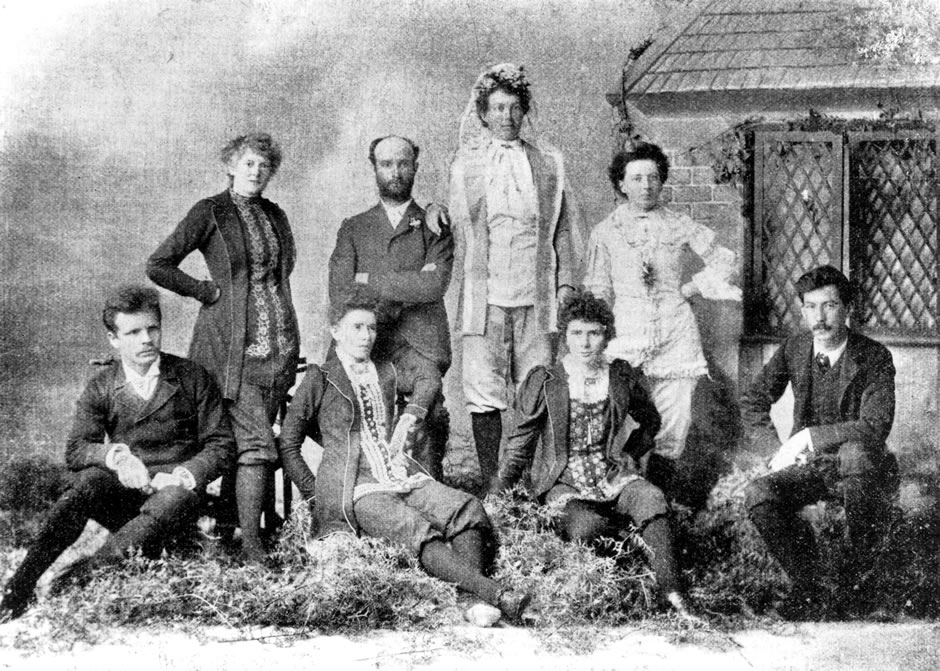This essay written by Jane Malthus was first published in Women Together: a History of Women's Organisations in New Zealand in 1993.
The New Zealand Rational Dress Association (NZRDA) was formed at a meeting in the Women’s Christian Temperance Union (WCTU) rooms in Christchurch on 14 May 1894. Its founding members were those 'ladies and gentlemen' present, with Alice Burn elected president, Kate Wilkinson (born Walker) as vice-president, Miss Meredith (Burn's sister) as secretary and a Mrs Ingram as treasurer. The association's aim was 'to bring about that change in women's dress which her wider life and increased activity seem to demand'. [1] The adoption of trousers or knickers as outerwear, or at least as underwear, was to be encouraged.
The extent to which fashionable women's dress in the late nineteenth century restricted women's activities had been debated in newspapers around the country for some years. The divided skirt question was 'bifurcating feminine opinion as distinctly as the skirt itself is divided', wrote one commentator. [2] Views on tight lacing and the wearing of corsets had been published since the early 1880s, and local and overseas reports of women adopting rational dress for sport and exercise appeared increasingly in the 1890s, at times alongside illustrations and descriptions of the latest in fashionable dress.
Wilkinson (born Walker), a school teacher and keen cyclist, had already collaborated with her future husband James on a 35-page pamphlet on dress reform, in which they pointed out the inequalities between males and females in physical activities, choice of occupation and dress. The skirt, they wrote, was 'the greatest of hindrances still barring women's healthy progress'. [3] Unhampered by skirt or corset, women would have greater freedom of movement, improved beauty and a 'healthy undistorted form', [4] all of which would benefit themselves and the economy, since active, fit women could undertake a greater variety of employment.
Walker and Wilkinson suggested that reform dress could be adopted in stages: discarding corsets first, then adopting divided underskirts, shortening the outer skirt, wearing turkish trousers or a divided outer skirt, wearing a long tunic and knickers and eventually accepting a 'nicely fitting knicker suit for work and exercise'. [5] They offered patterns and photos of reform dress designed by Burn, which they described as pretty and not at all masculine looking. They also suggested that 'Households in favour would best promote the movement by forming themselves into local centres, applying for association under the nearest Women's Institute, for meetings of the neighbourhood to discuss and practise Dress Reform and what it implies.' [6]
Reform of women's dress was an issue that the Canterbury Women's Institute and the Women's Christian Temperance Union (WCTU) had supported for some years. However, the founders of the NZRDA obviously felt that an organisation dedicated to dress reform was necessary to overcome the general resistance of women (and men) to its adoption. By the time of the inaugural meeting in May 1894, two of the association's founders had already gained some notoriety for wearing reform dress. Burn had been publicly reprimanded by the Canterbury College governors for wearing rational dress on the university campus, and Walker wore breeches and a veil for her wedding to Wilkinson on 13 January 1894. A photograph of the wedding party, which included Burn and Meredith, was published in the New Zealand Graphic and Ladies' Journal.

Auckland City Libraries - Tāmaki Pātaka Kōrero, Sir George Grey Special Collections
Kate Walker (standing, centre) and James Wilkinson (seated beside her) at their wedding in 1894, with Alice Burn, first president of the Rational Dress Association, and Miss Meredith, the treasurer. The photograph was published in the New Zealand Graphic and Ladies' Journal 3 March 1894.
At the second meeting of the association, on 21 May 1894, a constitution was adopted and rules of membership established. The meeting also decided to encourage the formation of branches throughout the colony. But although lively debate over corsets, divided skirts and knickers continued in the press, there is little evidence that the New Zealand Rational Dress Association expanded or even continued to exist. It is likely that the sentiments expressed by the Dunedin correspondent for the New Zealand Graphic and Ladies' Journal were widespread:
what we want is a style of dress that will suit all classes of women equally – rich and poor, young and old alike – something that will relieve us of the burden of heavy skirts without making us conspicuous, and doing away with the gracefulness of female attire. . . . Women love their furbelows too well to sacrifice them for any thing hideous. [7]
Jane Malthus
Notes
[1] Christchurch Press, 15 May 1894; Otago Witness, 17 May 1894.
[2] New Zealand Graphic and Ladies' Journal, 19 July 1890, p. 15.
[3] Walker and Wilkinson, 1893, p. 18
[4] Walker and Wilkinson, 1893, p. 21.
[5] Walker and Wilkinson, 1893, p. 23.
[6] Walker and Wilkinson, 1893, p. 35.
[7] New Zealand Graphic and Ladies' Journal, 24 January 1891, p. 16.
Published sources
Malthus, Jane, '"Bifurcated and Not Ashamed": Late Nineteenth Century Dress Reformers in New Zealand', NZJH, Vol. 23 No. 1, 1989, pp. 32–46
Walker, Kate and James Wilkinson, Notes on Dress Reform and What it Implies, Simpson and Williams, Christchurch, 1893

Community contributions